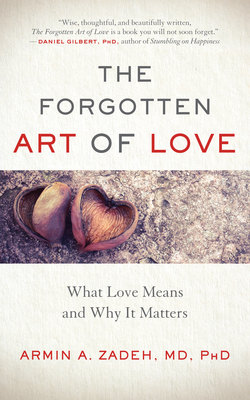Читать книгу The Forgotten Art of Love - Armin A. Zadeh - Страница 10
На сайте Литреса книга снята с продажи.
Оглавление3. Love as an Art
An art is a skillful human activity undertaken to express a person’s perceptions and emotions. Can love be considered an art? To address this question, we first need to explore the mechanism of loving. How do we generate love in ourselves?
Love can be seen simply as a biological impulse that is unique among our drives because of its significance for human survival. Drives like hunger or thirst are activated in response to internal or external triggers: for example, low blood sugar levels elicit the feeling of hunger. A drive that prompts us to eat is obviously vital to sustaining the functioning of the individual.
The effect of all these drives on our state of mind ceases once we have satisfactorily responded to them, for example by eating in response to hunger or engaging in sex when aroused. Thus, their effect is largely transient and beyond our control. Indeed, people generally view the fleeting nature of the pleasure these drives generate as unsatisfactory. Even our greatest highs don’t last. The huge success of a challenging project or business deal may make us euphoric for a while, but eventually that feeling fades. For an athlete who breaks a world record in sports, life goes back to normal a few weeks later. We always retain the sense of satisfaction from an accomplishment, but the joy and excitement do not last. When falling in love, we may feel elated for months, but then even these feelings will fade. To revive them, we repeat the actions that bring us pleasure. Many, if not most, of us are dopamine junkies and keep pursuing activities to give us the temporary highs.
Love is different. Love — as the urge and continuous effort for the well-being and happiness of somebody — is a committed state that is maintained until we no longer see beauty, goodness, or uniqueness in the beloved. In contrast to the fleeting nature of other pleasurable drives, the emotions associated with love — including joy, contentment, and affection — have a sustained effect on our state of mind. Unfortunately, because we often allow competing drives to dominate, we don’t always enjoy the pleasing emotions arising from love. Herein lies our fundamental problem with love: we easily lose our focus on it and let our minds be distracted. When that happens, our loving feelings are repressed until we regain our focus on love.
A few examples may illustrate this concept. A nine-year-old boy has just smashed an expensive vase while chasing after his brother. The boy’s father immediately perceives the impulse of severe anger. This anger results from possessive and territorial instincts, and the father feels the urge to furiously reprimand or even slap the child. His love for his son is entirely suppressed at this moment by the force of the anger drive. But if the father takes a deep breath and, instead of acting on his anger, considers the accidental nature of the event and the boisterous nature of children’s play, he can recognize the anxiety, remorse, and distress his son is feeling. The father can then wrap his arms around his son and console him. Both feel the soothing, comforting sensation of love.
In this situation, the father must suppress the impulse of anger to allow love to prevail. While the drive for anger comes on instantaneously and subconsciously, almost as a reflex, the drive for love surfaces only after the father recognizes his anger and actively and consciously rejects it. This concept is critical for understanding the dynamics of loving.
Another example further illustrates the underlying forces of love. A married woman receives sexual advances from a colleague. The woman feels aroused by the advances and perceives the desire to follow her impulse. At that moment, her mind is preoccupied with sexual arousal. When consciously recognizing her excitement, however, she realizes that giving in to her impulse would hurt her partner, whom she loves. Indeed, she would be betraying her effort for her spouse’s happiness and well-being. The woman rejects her impulse for sexual activity and refuses the colleague’s advances. Once she has done so, she feels love for her spouse. Again, she must actively reject a competing impulse in order to allow love to have its effect.
Another very common scenario is finding it difficult to act in a loving way when we are hungry. Here again, the influences of different essential drives collide. Many people are irritable and may even lash out at others when hungry but return to their regular, caring selves once they have eaten.
